This article has been
cited by other articles in ScienceCentral.
Abstract
Institute of Cancer Research (ICR) mice have been widely used in various research fields including toxicology, oncology, pharmacology, and pharmaceutical product safety testing for decades. However, annual tendency of research papers involving ICR mice in various biomedical fields has not been previously analyzed. In this study, we examined the numbers of papers that used ICR mice as experimental animals in the social science, natural science, engineering, medicine-pharmacy, marine agriculture-fishery, and art-kinesiology fields by analyzing big data. Numbers of ICR mouse-used papers gradually increased from 1961 to 2014, but small decreases were observed in 2015 and 2016. The largest number of ICR-used papers were published in the medicine-pharmacy field, followed by natural science and art-kinesiology fields. There were no ICR mouse-used papers in other fields. Furthermore, ICR mice have been widely employed in cell biology studies within the natural science field as well as in biochemistry and pathology in the medicine-pharmacy field. Few ICR mouse-used papers were published in exercise biochemistry and exercise nutrition in the art-kinesiology field. Regardless in most fields, the total numbers of published papers involving ICR mice were higher in 2014 than in other years, although the numbers in some fields including dentistry, veterinary science, and dermatology were high in 2016. Taken together, the present study shows that various ICR stocks, including Korl:ICR mice, are widely employed as experimental animals in various biomedical research fields.
Go to :

Keywords: ICR mice, Korl:ICR mouse, trend, biomedical field, published papers
Institute of Cancer Research (ICR) mouse stocks in the USA originated from a colony of Swiss mice that originally consisted of two male and seven female albino mice derived from a non-inbred stock in the laboratory of Dr. de Coulon, Centre Anticancereux Romand, Lausanne, Switzerland [
1]. After importation of offspring from that colony into the USA by Dr. Clara Lynch of the Rockefeller Institute in 1926, the Hauschka Ha/ICR stock was established from Swiss mice of Rockefeller origin in 1948 as the first ICR stock at the Institute for Cancer Research in Philadelphia. Subsequently, mice from the Hauschka Ha/ICR stock were distributed to various breeding companies around the world (
Figure 1) [
2]. After these distributions, many ICR stocks were established by various companies, universities, and institutes and then registered as novel stocks with the Institute for Laboratory Animal Research (ILAR). As part of above studies, the Korl:ICR stock has been established by the National Institute of Food and Drug Safety Evaluation (NIFDS) in Korea as a new stock that is distinct from other ICR stocks. The Korl:ICR stock has shown no significance differences from other ICR stocks in several common biological phenotype characteristics such as responses to constipation and gastric ulcer inducers [
34].
 | Figure 1Pedigree of commercially available outbred stocks [13]. Most currently available outbred stocks originated from a single Swiss colony of 200 mice derived from 2 male and 7 female mice. The stocks include NMRI, CFW, MF1, CD1, ICR, NIHS, ND4, and SW.
|
ICR mice are one the most commonly available outbred population because they have good reproductive performance, are inexpensive, robust, and grow rapidly [
56]. In particular, they are widely used in various research fields including toxicology, cancer, pharmacology, as well as in product safety testing, transgenesis experiments, and mouse genetic mapping [
5678]. Furthermore, differences in responses to some chemicals and hormones among several ICR stocks have been investigated in order to elucidate the physiological properties of ICR mice stocks obtained from different sources. To date, these studies have focused on the incidence of 5-azacytidineinduced exencephaly [
9], lung injury by butylated hydroxytoluene [
10], styrene-induced hepato/pneumotoxicity [
11], the responses to growth hormones by chondrocytes [
12], and constipation induced by loperamide [
3]. However, there are no reports providing the annual tendency of the research papers used ICR mice in the social science, natural science, engineering, medicinepharmacy, marine-agriculture-fishery, and arts-kinesiology fields. In this study, we analyzed the yearly trends in ICR mice usage in papers published in various scientific fields by analyzing big data. The selected fields were based on the classification catalog of the National Research Foundation of Korea (
Table 1).
Table 1
Major and minor category for big data analysis
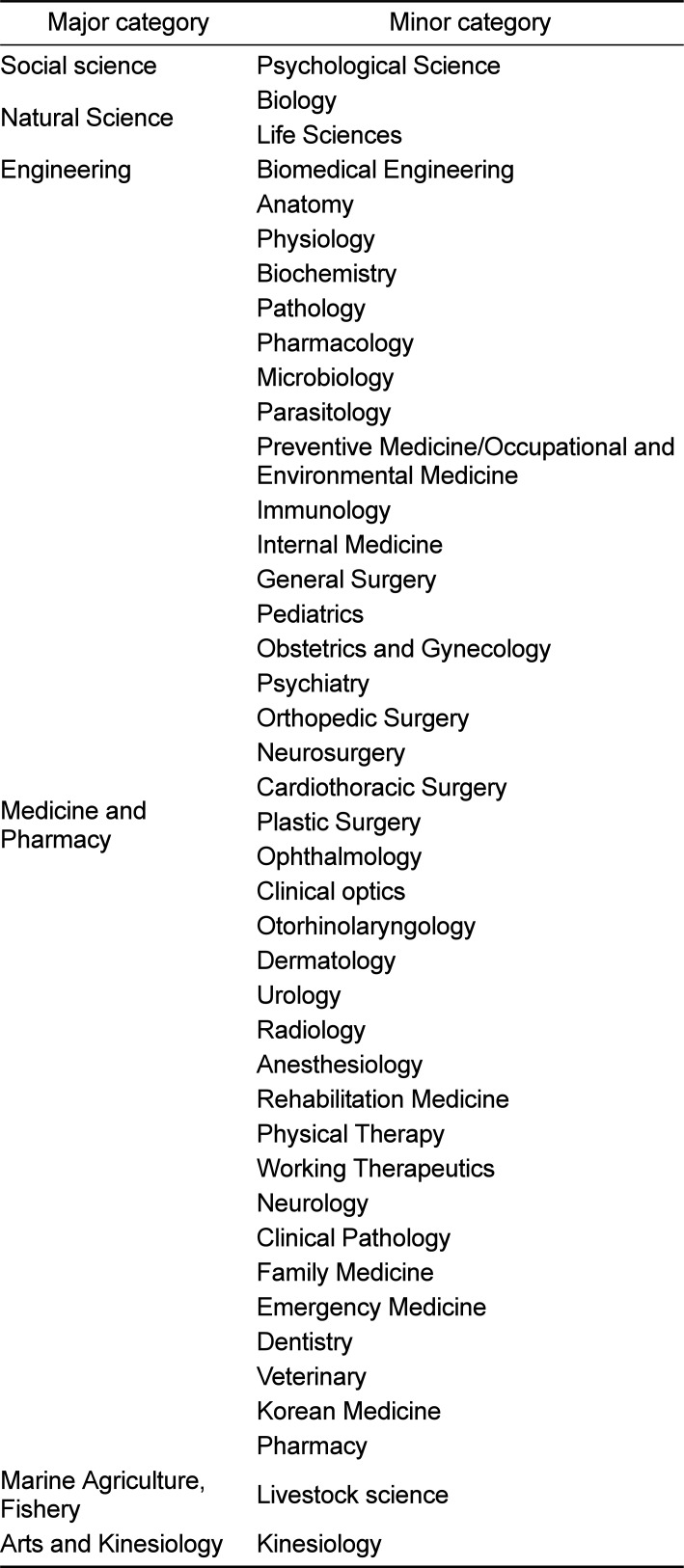
|
Major category |
Minor category |
|
Social science |
Psychological Science |
|
Natural Science |
Biology |
|
Life Sciences |
|
Engineering |
Biomedical Engineering |
|
Medicine and Pharmacy |
Anatomy |
|
Physiology |
|
Biochemistry |
|
Pathology |
|
Pharmacology |
|
Microbiology |
|
Parasitology |
|
Preventive Medicine/Occupational and Environmental Medicine |
|
Immunology |
|
Internal Medicine |
|
General Surgery |
|
Pediatrics |
|
Obstetrics and Gynecology |
|
Psychiatry |
|
Orthopedic Surgery |
|
Neurosurgery |
|
Cardiothoracic Surgery |
|
Plastic Surgery |
|
Ophthalmology |
|
Clinical optics |
|
Otorhinolaryngology |
|
Dermatology |
|
Urology |
|
Radiology |
|
Anesthesiology |
|
Rehabilitation Medicine |
|
Physical Therapy |
|
Working Therapeutics |
|
Neurology |
|
Clinical Pathology |
|
Family Medicine |
|
Emergency Medicine |
|
Dentistry |
|
Veterinary |
|
Korean Medicine |
|
Pharmacy |
|
Marine Agriculture, Fishery |
Livestock science |
|
Arts and Kinesiology |
Kinesiology |

The total number of published papers that used ICR mice as experimental animals gradually increased from 1961 to 2016, although a slight decrease was observed in 2015 and 2016. Notably, the numbers rapidly increased after 2010, while a more constant level was maintained during the 1960s (
Figure 2A). Among all categories of biomedical research, the largest level of ICR mouse usage was in the medicine-pharmacy field, followed by those in natural science and arts-kinesiology. Especially, the cell biology and biochemistry field had large number of papers used ICR mice (
Figure 2B). However, that trend was not observed in the social science, engineering, and marine-agriculture-fishery fields. In addition, the total number of published papers that involved ICR mice showed only slight increases in the medicine-pharmacy and arts-kinesiology fields in 2014 and 2015, and a constant level was maintained in the natural science field during the same period (
Figure 3). Within the natural sciences, the number of published papers that involved ICR mice as experimental animals was largest in the cell biology field (350 papers) followed by genetics (55 papers), molecular biology (40 papers), microbiology (13 papers), and nutritional studies (5 papers) at 2014 (
Figure 4). The most fields in the natural sciences maintained a relatively constant level of paper number during 2013-2015 and then decreased their number in 2016 (
Figure 4).
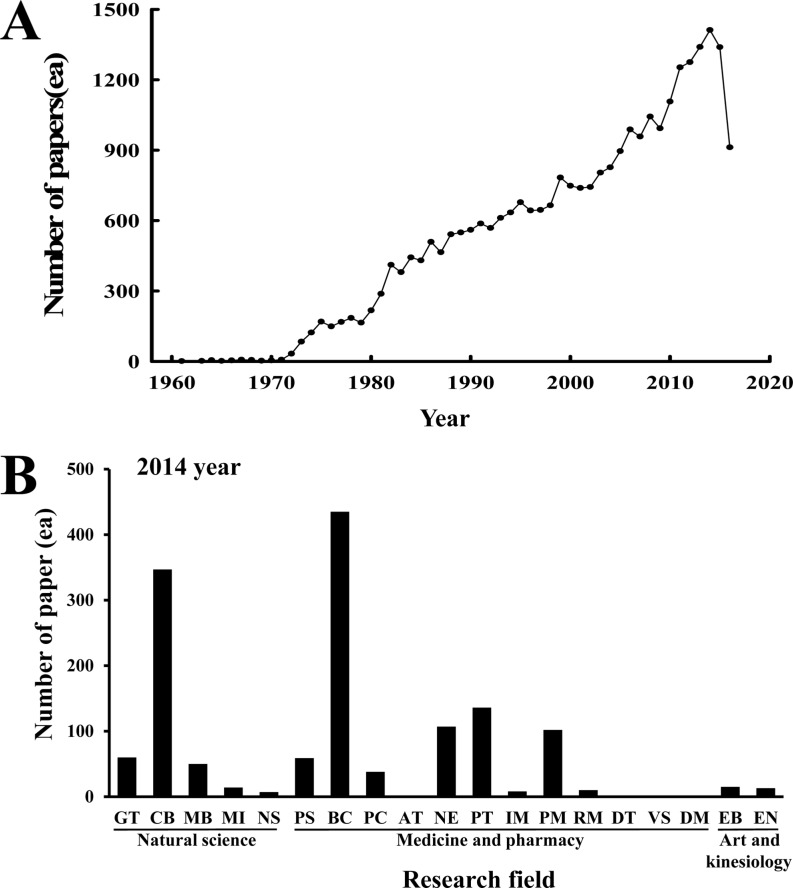 | Figure 2Tendency in the annual number of published papers that included ICR mice as experimental animals. (A) Annual tendency of total published papers involving ICR mice. These numbers were obtained by analyzing big data from 1961 to 2016. (B) Number of paper used ICR mice in each research field. The number of papers published in 2014 classified into each research field based on the classification catalog of the National Research Foundation of Korea. Abbreviations; GT, Genetics; CB, Cell biology; MB, Molecular biology; MI, Microbiology; NS, Nutritional studies; PS, Physiology; BC, Biochemistry; PC, Psychiatry; AT, Anesthesiology; NE, Neurology; PT, Pathology; IM, Immunology; PM, Pharmacology; RM, Rehabilitation medicine; DT, Dentistry; VS, Veterinary science; DM, Dermatology; EB, Exercise biochemistry; EN, Exercise nutrition.
|
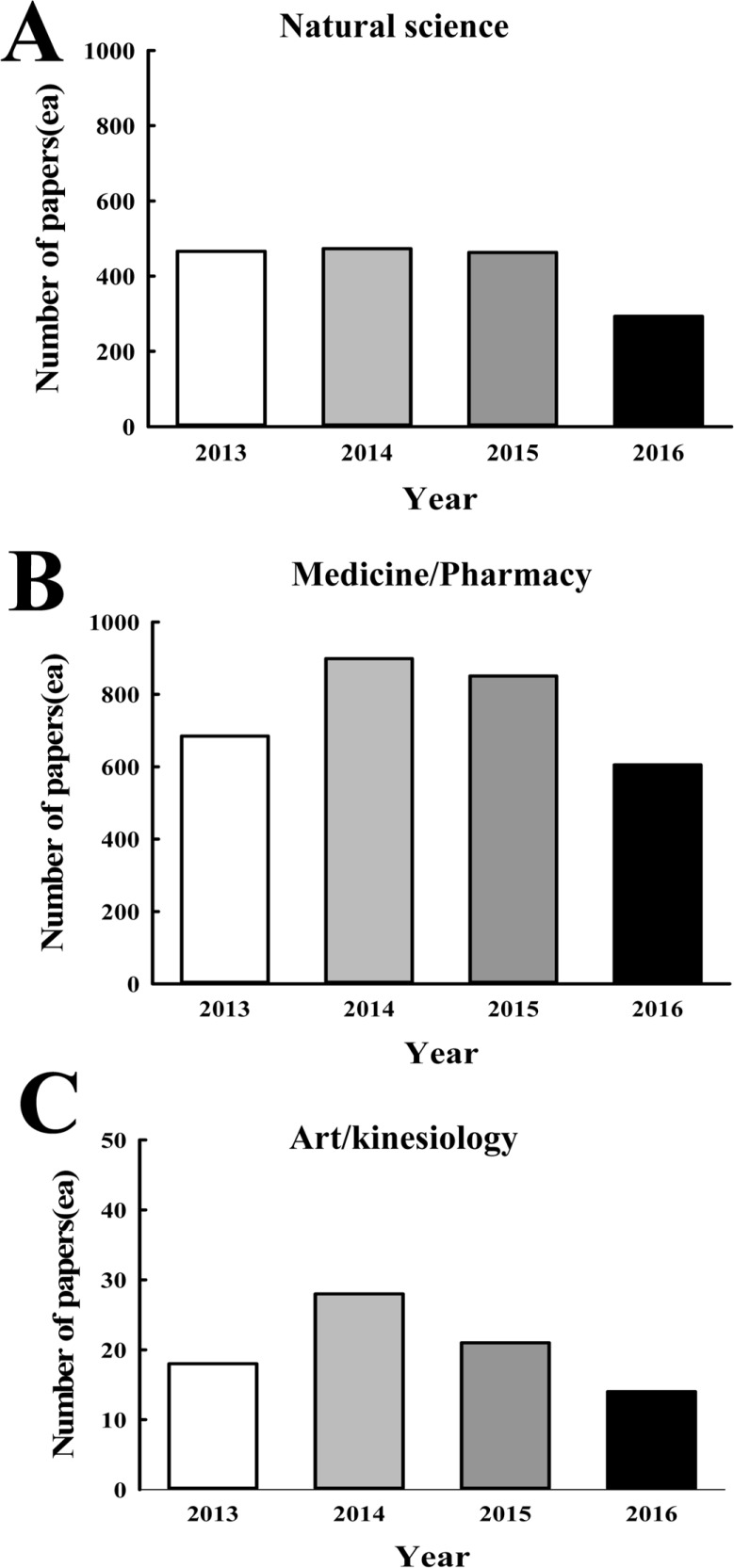 | Figure 3Annual tendency in numbers of published papers involving ICR mice in three different fields. Total papers per year were reanalyzed into natural science, medicine-pharmacy, and art-kinesiology fields based on the classified catalog of the National Research Foundation of Korea.
|
 | Figure 4Current (2013-2016) tendency in the annual number of published papers involving ICR mice in the natural sciences including genetics, cell biology, molecular biology, microbiology, and nutritional studies.
|
Furthermore, in the medicine-pharmacy field, the largest number of papers involving ICR mice were related to biochemistry research, followed by those in pathology, neurobiology, pharmacology, physiology, psychiatry, and rehabilitation medicine. However, there were very small numbers of papers involving ICR mice in anesthesiology, dentistry, immunology, veterinary science, and dermatology. In those research areas, the numbers were high in 2014 and 2015, followed by a small decrease in 2016. Moreover, there was a marked annual increase in the number of papers involving ICR mice in the anesthesiology, veterinary science, and dermatology fields (
Figure 5).
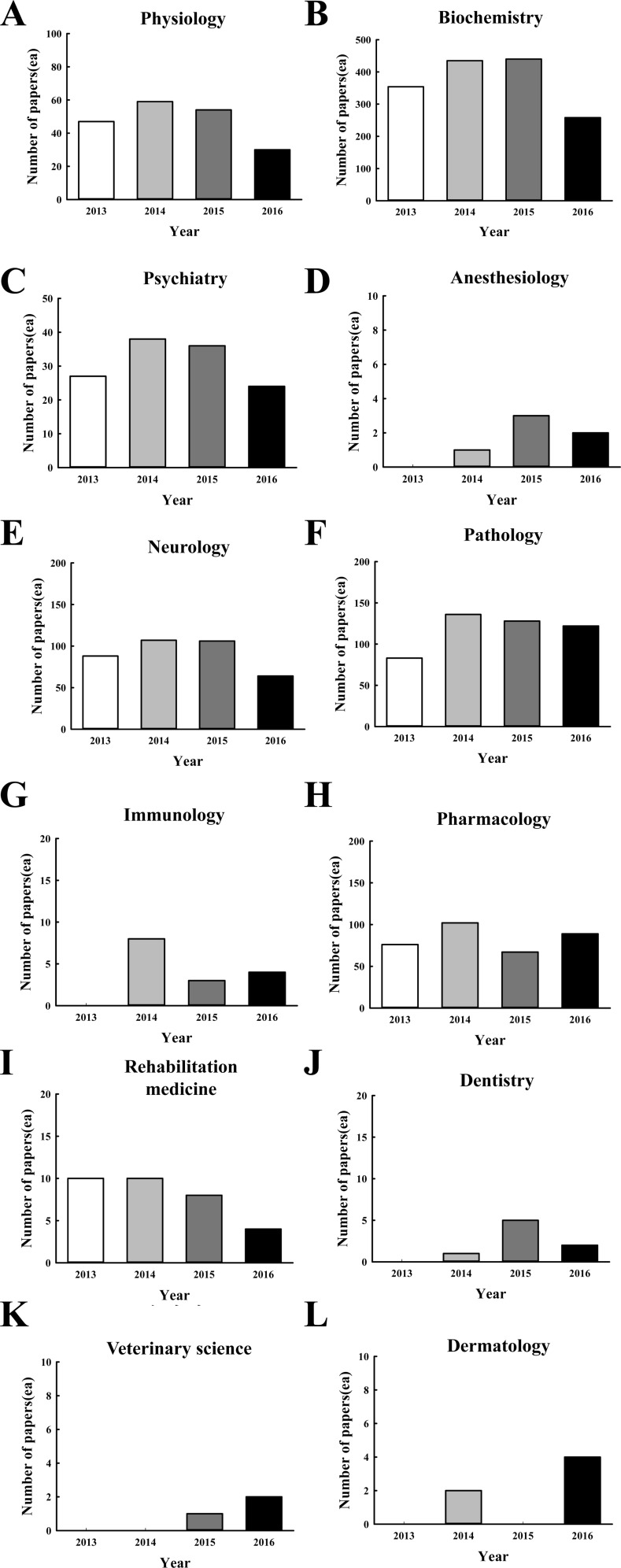 | Figure 5Current (2013-2016) tendency in the annual number of published papers involving ICR mice in the medicine-pharmacy field including physiology, biochemistry, psychiatry, anesthesiology, neurology, pathology, immunology, pharmacology, rehabilitation medicine, dentistry, veterinary science, and dermatology.
|
Finally, within the various sections of the artskinesiology field, ICR mice were only used in papers related to exercise biochemistry and exercise nutrition during 2013-2015. In the arts-kinesiology field, the number of papers involving ICR mice was highest in 2014 followed by a gradual decrease in 2015 and 2016 (
Figure 6).
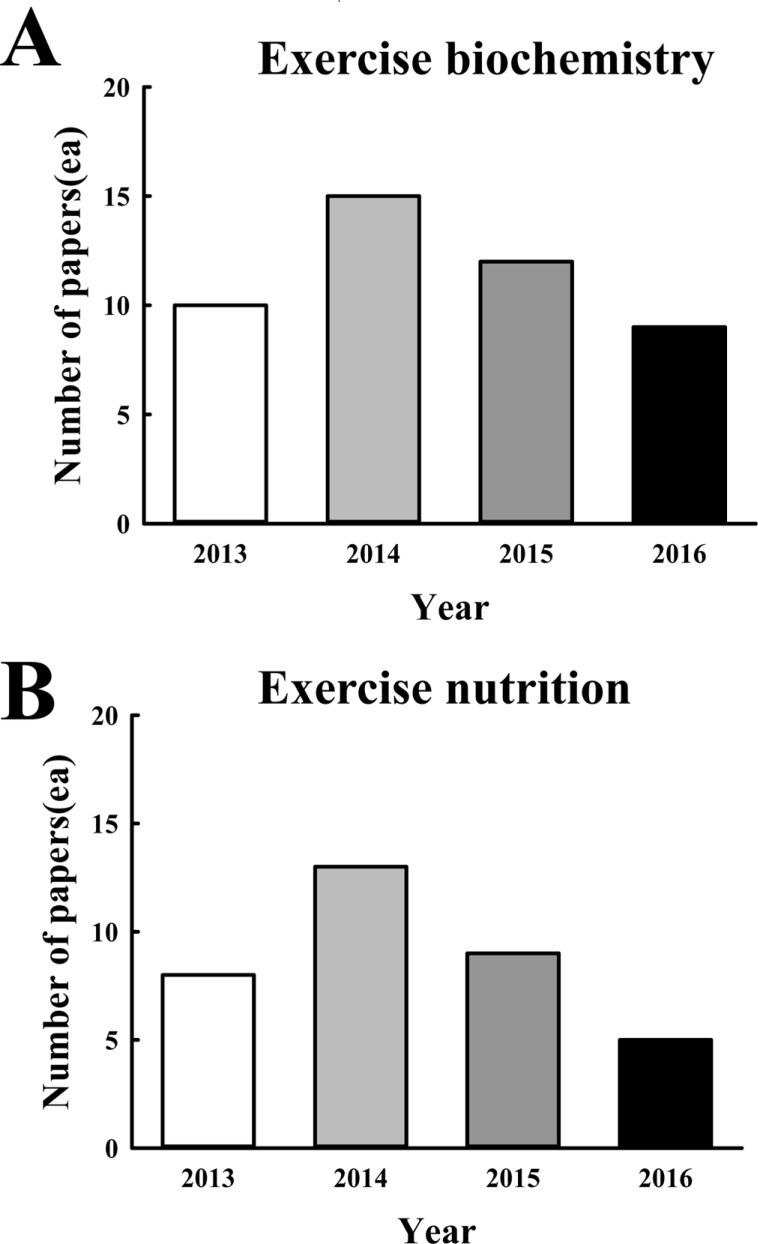 | Figure 6Current (2013-2016) tendency in the annual number of published papers involving ICR mice in art-kinesiology research including exercise biochemistry and exercise nutrition.
|
In summary, we analyzed the annual tendency in publication of papers that used ICR mice as experimental animals in six biomedical fields (social science, natural science, engineering, medicine-pharmacy, marine agriculturefishery, and art-kinesiology) during the period 1961-2016 by analyzing big data. Especially, we focused the number of papers per each research topic within those fields over the period 2013-2016. The above results indicate year-by-year expansion in the use of ICR mice in various research areas and indicates the importance of establishing and characterizing novel stocks of ICR mice.
Acknowledgments
This project was supported by a 2015 grant from BIOREIN (Laboratory Animal Bio Resources Initiative) of the Korean Ministry of Food and Drug Safety.
Go to :

Notes
Go to :

References
1. Lynch CJ. The so-called Swiss mouse. Lab Anim Care. 1969; 19(2):214–220. PMID:
4240230.
2. Rice MC, O'Brien SJ. Genetic variance of laboratory outbred Swiss mice. Nature. 1980; 283(5743):157–161. PMID:
7350540.

3. Kim JE, Yun WB, Sung JE, Lee HA, Choi JY, Choi YS, Jung YS, Kim KS, Hwang DY. Characterization the response of Korl:ICR mice to loperamide induced constipation. Lab Anim Res. 2016; 32(4):231–240. PMID:
28053617.

4. Song SH, Kim JE, Go J, Koh EK, Sung JE, Lee HA, Choi KM, Kim HD, Jung YS, Kim KS, Hwang DY. Comparison of the response using ICR mice derived from three different sources to ethanol/hydrochloric acid-induced gastric injury. Lab Anim Res. 2016; 32(1):56–64. PMID:
27051443.

5. Cui S, Chesson C, Hope R. Genetic variation within and between strains of outbred Swiss mice. Lab Anim. 1993; 27(2):116–123. PMID:
8501892.

6. Chia R, Achilli F, Festing MF, Fisher EM. The origins and uses of mouse outbred stocks. Nat Genet. 2005; 37(11):1181–1186. PMID:
16254564.

7. Lehoczky JA, Cai WW, Douglas JA, Moran JL, Beier DR, Innis JW. Description and genetic mapping of Polypodia: an X-linked dominant mouse mutant with ectopic caudal limbs and other malformations. Mamm Genome. 2006; 17(9):903–913. PMID:
16964440.

8. Brown JA, Chua SC Jr, Liu SM, Andrews MT, Vandenbergh JG. Spontaneous mutation in the db gene results in obesity and diabetes in CD-1 outbred mice. Am J Physiol Regul Integr Comp Physiol. 2000; 278(2):R320–R330. PMID:
10666131.
9. Matsuda M. Comparison of the incidence of 5-azacytidine-induced exencephaly between MT/HokIdr and Slc:ICR mice. Teratology. 1990; 41(2):147–154. PMID:
1690922.

10. Kehrer JP, DiGiovanni J. Comparison of lung injury induced in 4 strains of mice by butylated hydroxytoluene. Toxicol Lett. 1990; 52(1):55–61. PMID:
2356571.

11. Carlson GP. Comparison of mouse strains for susceptibility to styrene-induced hepatotoxicity and pneumotoxicity. J Toxicol Environ Health. 1997; 51(2):177–187. PMID:
9176557.

12. Livne E, Laufer D, Blumenfeld I. Comparison of
in vitro response to growth hormone by chondrocytes from mandibular condyle cartilage of young and old mice. Calcif Tissue Int. 1997; 61(1):62–67. PMID:
9192516.
13. Yalcin B, Nicod J, Bhomra A, Davidson S, Cleak J, Farinelli L, Østerås M, Whitley A, Yuan W, Gan X, Goodson M, Klenerman P, Satpathy A, Mathis D, Benoist C, Adams DJ, Mott R, Flint J. Commercially available outbred mice for genome-wide association studies. PLoS Genet. 2010; 6(9):e1001085. PMID:
20838427.

Go to :









 PDF
PDF ePub
ePub Citation
Citation Print
Print





 XML Download
XML Download